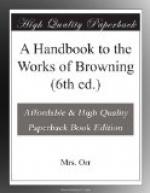Mr. Browning was not personally acquainted with either John Sterling or Caroline Fox, and what he knew of the former as a poet did not, to his mind, bear out this marked objection to wordiness. Still, he gave the joint criticism all the weight it deserved; and much more than it deserved in the case of Miss Fox, whom he imagined, from her self-confident manner, to be a woman of a certain age, instead of a girl some years younger than himself; and often, he tells us, during the period immediately following, he contented himself with two words where he would rather have used ten. The harsh and involved passages in “Sordello,” which add so much to the remoteness of its thought, were the first consequence of this lesson. “Pauline” and “Paracelsus” had been deeply musical, and the music came back to their author’s verse with the dramas, lyrics, and romances by which “Sordello” was followed. But the dread of being diffuse had doubly rooted itself in his mind, and was to bear fruit again as soon as the more historical or argumentative mood should prevail.
The determination never to sacrifice sense to sound is the secret of whatever repels us in Mr. Browning’s verse, and also of whatever attracts. Wherever in it sense keeps company with sound, we have a music far deeper than can arise from mere sound, or even from a flow of real lyric emotion, which has its only counterpart in sound. It is in the idea, and of it. It is the brain picture beating itself into words.
The technical rules by which Mr. Browning works, carry out his principle to the fullest extent.
I. He uses the smallest number of words which his meaning allows; is particularly sparing in adjectives.
II. He uses the largest relative number of Saxon (therefore picturesque) words.[4]
III. He uses monosyllabic words wherever this is possible.
IV. He farther condenses his style by abbreviations and omissions, of which some are discarded, but all warranted by authority: “in,” “on,” and “of,” for instance, become “i’,” “o’,” and “o’.” Pronouns, articles, conjunctions, and prepositions are, on the same principle, occasionally left out.
V. He treats consonants as the backbone of the language, and hence, as the essential feature in a rhyme; and never allows the repetition of a consonant in a rhyme to be modified by a change in the preceding vowel, or by the recurrence of the rhyming syllable in a different word—or the repetition of a consonant in blank verse to create a half-consonance resembling a rhyme: though other poets do not shrink from doing so.[5]
VI. He seldom dilutes his emphasis by double rhymes, reserving these—especially when made up of combined words, and producing a grotesque effect—for those cases in which the meaning is given with a modifying colour: a satirical, or self-satirical, intention on the writer’s part. Strong instances of this occur in “The Flight of the Duchess,” “Christmas Eve,” and “Pacchiarotto.”




